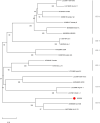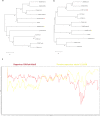A novel recombinant porcine sapovirus infection in piglets with diarrhea in Shandong Province, China, 2022
- PMID: 37036658
- PMCID: PMC10235293
- DOI: 10.1007/s42770-023-00963-x
A novel recombinant porcine sapovirus infection in piglets with diarrhea in Shandong Province, China, 2022
Abstract
Sapporo virus (SaV) is an emerging enteric virus causing acute gastroenteritis in animals. Here, we found a novel porcine SaV (PoSaV) strain (named SD2202) from the piglets with diarrhea in China in 2022. The highest nucleotide homology of SD2202 with other PoSaV strains is only 90.67%, and there are four amino acids insertion in the viral capsid protein and minor structural protein compared to other PoSaV; furthermore, we found that SD2202 belongs to a new GIII genogroup clade (GIII-6 clade). Interestingly, we found that SD2202 may be an intra-genogroup recombinant strain. Taken together, we found a novel PoSaV implicated in the piglet diarrhea epidemic and emphasized the importance of continuous surveillance of PoSaV.
Keywords: Emerging infectious disease; Gene recombination; Sapovirus; Swine.
© 2023. The Author(s) under exclusive licence to Sociedade Brasileira de Microbiologia.
Conflict of interest statement
The authors declare no competing interests.
Figures



Similar articles
-
Genomic organization and recombination analysis of a porcine sapovirus identified from a piglet with diarrhea in China.Virol J. 2017 Mar 16;14(1):57. doi: 10.1186/s12985-017-0729-1. Virol J. 2017. PMID: 28302145 Free PMC article.
-
Serological and molecular investigation of porcine sapovirus infection in piglets in Xinjiang, China.Trop Anim Health Prod. 2016 Apr;48(4):863-9. doi: 10.1007/s11250-016-1023-8. Epub 2016 Feb 22. Trop Anim Health Prod. 2016. PMID: 26898687
-
Seroprevalence and molecular detection of porcine sapovirus in symptomatic suckling piglets in Guangdong Province, China.Trop Anim Health Prod. 2014 Mar;46(3):583-7. doi: 10.1007/s11250-013-0531-z. Epub 2014 Jan 10. Trop Anim Health Prod. 2014. PMID: 24407531
-
Porcine sapoviruses: Pathogenesis, epidemiology, genetic diversity, and diagnosis.Virus Res. 2020 Sep;286:198025. doi: 10.1016/j.virusres.2020.198025. Epub 2020 May 26. Virus Res. 2020. PMID: 32470356 Free PMC article. Review.
-
[Systematic review on the characteristics of acute gastroenteritis outbreaks caused by sapovirus].Zhonghua Liu Xing Bing Xue Za Zhi. 2019 Jan 10;40(1):93-98. doi: 10.3760/cma.j.issn.0254-6450.2019.01.019. Zhonghua Liu Xing Bing Xue Za Zhi. 2019. PMID: 30669739 Chinese.
Cited by
-
A dual typing system establishment and global diversity analysis for sapoviruses.BMC Genomics. 2024 Nov 22;25(1):1131. doi: 10.1186/s12864-024-11048-w. BMC Genomics. 2024. PMID: 39578768 Free PMC article.
-
Genomic Evolution and Selective Pressure Analysis of a Novel Porcine Sapovirus in Shanghai, China.Microorganisms. 2024 Mar 12;12(3):569. doi: 10.3390/microorganisms12030569. Microorganisms. 2024. PMID: 38543620 Free PMC article.
-
Complexity of Diarrhea-Associated Viruses in Stunted Pigs Identified by Viral Metagenomics.Transbound Emerg Dis. 2025 Jun 18;2025:1974716. doi: 10.1155/tbed/1974716. eCollection 2025. Transbound Emerg Dis. 2025. PMID: 40567259 Free PMC article.
References
MeSH terms
Grants and funding
- CXGC2023A10/Agricultural scientific and technological innovation project of Shandong Academy of Agricultural Sciences
- ZR2021MC119/Shandong Provincial Natural Science Foundation
- ZR2022MC007/Shandong Provincial Natural Science Foundation
- 2022CXGC010606/Great Scientific and Technological Innovation Projects in Shandong Province
- 2020CXGC010801/Great Scientific and Technological Innovation Projects in Shandong Province
LinkOut - more resources
Full Text Sources

